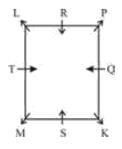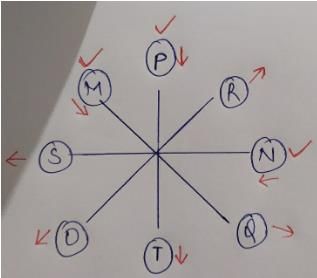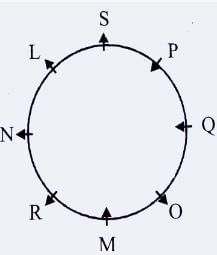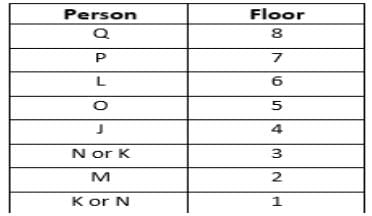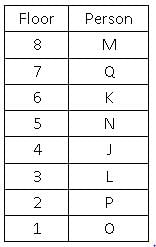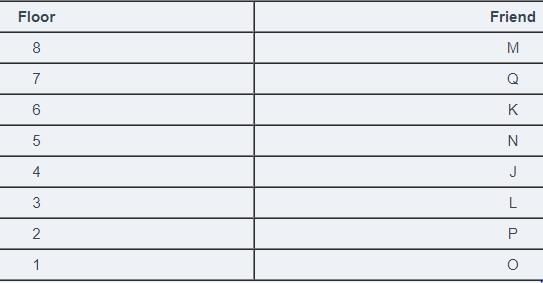Test: Seating Arrangement-3 - CLAT MCQ
20 Questions MCQ Test - Test: Seating Arrangement-3
Study the given information carefully and answer the given questions –
L, M, N, O, P, Q, R and S are sitting around a circular area at equal distances between each other, but not necessarily in the same order. Some of the people are facing the centre while some face outside (i.e., in a direction opposite to the centre).
Note: Facing the same direction means if one person faces the centre then the other person also faces the centre and vice versa.
Facing the opposite directions means if one person faces the centre then the other person faces outside and vice versa.
Immediate neighbours faces the same direction means if one neighbour faces the centre then the other neighour also faces the centre and vice versa.
Immediate neighbours face the opposite directions means if one neighbour faces the centre then the other neighbor faces outside and vice versa.
Only three people sit between L and M. Both L and M face opposite directions. Q sits to the immediate right of M. P sits third to the right of Q. Only two people sit between P and N.R sits to the immediate left of N. O sits third to the right of R. O is not an immediate neighbour of L. Both the immediate neighbours of L face the same direction. Both the immediate neighbours of P face the opposite directions. L sits second the right of P. S faces the centre.
Q.
What is R’s position with respect to P?
What is R’s position with respect to P?
Study the given information carefully and answer the given questions –
L, M, N, O, P, Q, R and S are sitting around a circular area at equal distances between each other, but not necessarily in the same order. Some of the people are facing the centre while some face outside (i.e., in a direction opposite to the centre).
Note: Facing the same direction means if one person faces the centre then the other person also faces the centre and vice versa.
Facing the opposite directions means if one person faces the centre then the other person faces outside and vice versa.
Immediate neighbours faces the same direction means if one neighbour faces the centre then the other neighour also faces the centre and vice versa.
Immediate neighbours face the opposite directions means if one neighbour faces the centre then the other neighbor faces outside and vice versa.
Only three people sit between L and M. Both L and M face opposite directions. Q sits to the immediate right of M. P sits third to the right of Q. Only two people sit between P and N.R sits to the immediate left of N. O sits third to the right of R. O is not an immediate neighbour of L. Both the immediate neighbours of L face the same direction. Both the immediate neighbours of P face the opposite directions. L sits second the right of P. S faces the centre.
Q.
How many persons are sitting facing centre –
How many persons are sitting facing centre –
Study the given information carefully and answer the given questions –
L, M, N, O, P, Q, R and S are sitting around a circular area at equal distances between each other, but not necessarily in the same order. Some of the people are facing the centre while some face outside (i.e., in a direction opposite to the centre).
Note: Facing the same direction means if one person faces the centre then the other person also faces the centre and vice versa.
Facing the opposite directions means if one person faces the centre then the other person faces outside and vice versa.
Immediate neighbours faces the same direction means if one neighbour faces the centre then the other neighour also faces the centre and vice versa.
Immediate neighbours face the opposite directions means if one neighbour faces the centre then the other neighbor faces outside and vice versa.
Only three people sit between L and M. Both L and M face opposite directions. Q sits to the immediate right of M. P sits third to the right of Q. Only two people sit between P and N.R sits to the immediate left of N. O sits third to the right of R. O is not an immediate neighbour of L. Both the immediate neighbours of L face the same direction. Both the immediate neighbours of P face the opposite directions. L sits second the right of P. S faces the centre.
Q.
Who are immediateneighbours of S?
Who are immediateneighbours of S?
Study the given information carefully and answer the given questions –
L, M, N, O, P, Q, R and S are sitting around a circular area at equal distances between each other, but not necessarily in the same order. Some of the people are facing the centre while some face outside (i.e., in a direction opposite to the centre).
Note: Facing the same direction means if one person faces the centre then the other person also faces the centre and vice versa.
Facing the opposite directions means if one person faces the centre then the other person faces outside and vice versa.
Immediate neighbours faces the same direction means if one neighbour faces the centre then the other neighour also faces the centre and vice versa.
Immediate neighbours face the opposite directions means if one neighbour faces the centre then the other neighbor faces outside and vice versa.
Only three people sit between L and M. Both L and M face opposite directions. Q sits to the immediate right of M. P sits third to the right of Q. Only two people sit between P and N.R sits to the immediate left of N. O sits third to the right of R. O is not an immediate neighbour of L. Both the immediate neighbours of L face the same direction. Both the immediate neighbours of P face the opposite directions. L sits second the right of P. S faces the centre.
Q.
Who is sitting immediate left of Q?
Study the given information carefully and answer the given questions –
L, M, N, O, P, Q, R and S are sitting around a circular area at equal distances between each other, but not necessarily in the same order. Some of the people are facing the centre while some face outside (i.e., in a direction opposite to the centre).
Note: Facing the same direction means if one person faces the centre then the other person also faces the centre and vice versa.
Facing the opposite directions means if one person faces the centre then the other person faces outside and vice versa.
Immediate neighbours faces the same direction means if one neighbour faces the centre then the other neighour also faces the centre and vice versa.
Immediate neighbours face the opposite directions means if one neighbour faces the centre then the other neighbor faces outside and vice versa.
Only three people sit between L and M. Both L and M face opposite directions. Q sits to the immediate right of M. P sits third to the right of Q. Only two people sit between P and N.R sits to the immediate left of N. O sits third to the right of R. O is not an immediate neighbour of L. Both the immediate neighbours of L face the same direction. Both the immediate neighbours of P face the opposite directions. L sits second the right of P. S faces the centre.
Q.
What is N’s position with respect to O?
Study the following information carefully and answer the questions given below:
K, L, M, P, Q, R, S and T are sitting around a square table in such a way that four of them sit, at four comers of the square while four sit in the middle of each of the four sides. The ones who sit at the four corners face outside while those who sit in the middle of the sides face the centre of the table. P sits third to the right of S. S faces the centre. Q sits third to the left of M. M does not sit in the middle of the sides. Only one person sits between Q and R. R is not an immediate neighbour of M. T face the centre. K is not an immediate neighbour of R.
Q.
What is position of M with respect to L?
Study the following information carefully and answer the questions given below:
K, L, M, P, Q, R, S and T are sitting around a square table in such a way that four of them sit, at four comers of the square while four sit in the middle of each of the four sides. The ones who sit at the four corners face outside while those who sit in the middle of the sides face the centre of the table. P sits third to the right of S. S faces the centre. Q sits third to the left of M. M does not sit in the middle of the sides. Only one person sits between Q and R. R is not an immediate neighbour of M. T face the centre. K is not an immediate neighbour of R.
Q.
Who sits exactly between Q and R?
Study the following information carefully and answer the questions given below:
K, L, M, P, Q, R, S and T are sitting around a square table in such a way that four of them sit, at four comers of the square while four sit in the middle of each of the four sides. The ones who sit at the four corners face outside while those who sit in the middle of the sides face the centre of the table. P sits third to the right of S. S faces the centre. Q sits third to the left of M. M does not sit in the middle of the sides. Only one person sits between Q and R. R is not an immediate neighbour of M. T face the centre. K is not an immediate neighbour of R.
Q.
Which of the following pairs represents the persons seated in the middle of the sides who face each other?
Study the following information carefully and answer the questions given below:
K, L, M, P, Q, R, S and T are sitting around a square table in such a way that four of them sit, at four comers of the square while four sit in the middle of each of the four sides. The ones who sit at the four corners face outside while those who sit in the middle of the sides face the centre of the table. P sits third to the right of S. S faces the centre. Q sits third to the left of M. M does not sit in the middle of the sides. Only one person sits between Q and R. R is not an immediate neighbour of M. T face the centre. K is not an immediate neighbour of R.
Q.
Who amongst the following sit between R and K when counted in anti-clockwise direction from K?
Study the following information carefully and answer the questions given below:
K, L, M, P, Q, R, S and T are sitting around a square table in such a way that four of them sit, at four comers of the square while four sit in the middle of each of the four sides. The ones who sit at the four corners face outside while those who sit in the middle of the sides face the centre of the table. P sits third to the right of S. S faces the centre. Q sits third to the left of M. M does not sit in the middle of the sides. Only one person sits between Q and R. R is not an immediate neighbour of M. T face the centre. K is not an immediate neighbour of R.
Q.
If K is made to face the opposite direction, who would sit to his immediate right?
Study the following information carefully and answer the questions given below:
Eight people – M, N, O, P, Q, R, S and T – are sitting around a circular are at equal distances between each other, but not necessarily in the same order. Some of the people are facing the centre while some face outside. (i.e., in a direction opposite to the centre).
Note: Facing the same direction means one faces the centre then the other also faces the centre and vice versa. Facing opposite direction means if one person faces centre then the other faces outside and vice versa.
S sits second to the right of P. P faces the centre. T sits second to the left of S. T is an immediate neighbour of both O and Q. R sits second to the left of Q. M sits second to the left of R. T sits second to the left of N. M sits second to the left of O. T faces the same direction as Q. N sits third to the right of M.
Q.
Who sits exactly between S and T, when counted from the left of S?
Study the following information carefully and answer the questions given below:
Eight people – M, N, O, P, Q, R, S and T – are sitting around a circular are at equal distances between each other, but not necessarily in the same order. Some of the people are facing the centre while some face outside. (i.e., in a direction opposite to the centre).
Note: Facing the same direction means one faces the centre then the other also faces the centre and vice versa. Facing opposite direction means if one person faces centre then the other faces outside and vice versa.
S sits second to the right of P. P faces the centre. T sits second to the left of S. T is an immediate neighbour of both O and Q. R sits second to the left of Q. M sits second to the left of R. T sits second to the left of N. M sits second to the left of O. T faces the same direction as Q. N sits third to the right of M.
Q.
How many people in the given arrangement face the centre?
Study the following information carefully and answer the questions given below:
Eight people – M, N, O, P, Q, R, S and T – are sitting around a circular are at equal distances between each other, but not necessarily in the same order. Some of the people are facing the centre while some face outside. (i.e., in a direction opposite to the centre).
Note: Facing the same direction means one faces the centre then the other also faces the centre and vice versa. Facing opposite direction means if one person faces centre then the other faces outside and vice versa.
S sits second to the right of P. P faces the centre. T sits second to the left of S. T is an immediate neighbour of both O and Q. R sits second to the left of Q. M sits second to the left of R. T sits second to the left of N. M sits second to the left of O. T faces the same direction as Q. N sits third to the right of M.
Q.
Who sits second to the right of N?
Study the following information carefully and answer the questions given below:
Eight people – M, N, O, P, Q, R, S and T – are sitting around a circular are at equal distances between each other, but not necessarily in the same order. Some of the people are facing the centre while some face outside. (i.e., in a direction opposite to the centre).
Note: Facing the same direction means one faces the centre then the other also faces the centre and vice versa. Facing opposite direction means if one person faces centre then the other faces outside and vice versa.
S sits second to the right of P. P faces the centre. T sits second to the left of S. T is an immediate neighbour of both O and Q. R sits second to the left of Q. M sits second to the left of R. T sits second to the left of N. M sits second to the left of O. T faces the same direction as Q. N sits third to the right of M.
Q.
Four of the following five are alike in a certain way based on the given sitting arrangement and so form a group. Which is the one that does not belong to the group?
Study the following information carefully and answer the questions given below:
Eight people – M, N, O, P, Q, R, S and T – are sitting around a circular are at equal distances between each other, but not necessarily in the same order. Some of the people are facing the centre while some face outside. (i.e., in a direction opposite to the centre).
Note: Facing the same direction means one faces the centre then the other also faces the centre and vice versa. Facing opposite direction means if one person faces centre then the other faces outside and vice versa.
S sits second to the right of P. P faces the centre. T sits second to the left of S. T is an immediate neighbour of both O and Q. R sits second to the left of Q. M sits second to the left of R. T sits second to the left of N. M sits second to the left of O. T faces the same direction as Q. N sits third to the right of M.
Q.
Which of the following is true regarding T as per the given sitting arrangement?
Study the following information carefully and answer the question given below:
Eight friends – J, K, L, M, N, O, P and Q – live on eight different floors of a building but not necessarily in the same order. The lower most floor of the building is numbered one, the one above that is numbered two and so one until the topmost floor is numbered eight. J lives on floor numbered four. Only two people live between J and O. Only one person lives between O and L. M lives immediately above Q. M lives on an even numbered floor. Only one person lives between Q and N. Only one person lives between M and K. K does not live on the topmost floor.
Q. Four of the following five are alike as per the given arrangement and thus form a group. Which of the following does not belong to that group?
Study the following information carefully and answer the question given below:
Eight friends – J, K, L, M, N, O, P and Q – live on eight different floors of a building but not necessarily in the same order. The lower most floor of the building is numbered one, the one above that is numbered two and so one until the topmost floor is numbered eight. J lives on floor numbered four. Only two people live between J and O. Only one person lives between O and L. M lives immediately above Q. M lives on an even numbered floor. Only one person lives between Q and N. Only one person lives between M and K. K does not live on the topmost floor.
Q.
What is the position of M?
Study the following information carefully and answer the question given below:
Eight friends – J, K, L, M, N, O, P and Q – live on eight different floors of a building but not necessarily in the same order. The lower most floor of the building is numbered one, the one above that is numbered two and so one until the topmost floor is numbered eight. J lives on floor numbered four. Only two people live between J and O. Only one person lives between O and L. M lives immediately above Q. M lives on an even numbered floor. Only one person lives between Q and N. Only one person lives between M and K. K does not live on the topmost floor.
Q.
Who amongst the following lives exactly in the middle of thefriends who lives fifth from the bottom and second from the top?
Study the following information carefully and answer the question given below:
Eight friends – J, K, L, M, N, O, P and Q – live on eight different floors of a building but not necessarily in the same order. The lower most floor of the building is numbered one, the one above that is numbered two and so one until the topmost floor is numbered eight. J lives on floor numbered four. Only two people live between J and O. Only one person lives between O and L. M lives immediately above Q. M lives on an even numbered floor. Only one person lives between Q and N. Only one person lives between M and K. K does not live on the topmost floor.
Q.
Which of the following statements is true regarding N?
Study the following information carefully and answer the question given below:
Eight friends – J, K, L, M, N, O, P and Q – live on eight different floors of a building but not necessarily in the same order. The lower most floor of the building is numbered one, the one above that is numbered two and so one until the topmost floor is numbered eight. J lives on floor numbered four. Only two people live between J and O. Only one person lives between O and L. M lives immediately above Q. M lives on an even numbered floor. Only one person lives between Q and N. Only one person lives between M and K. K does not live on the topmost floor.
Q.
If all the given persons are made to live in an alphabetical order form bottom to top, the position of how many of them will remain unchanged?



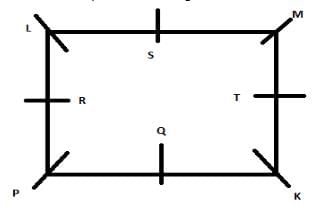 Thus M is five right to R.
Thus M is five right to R.